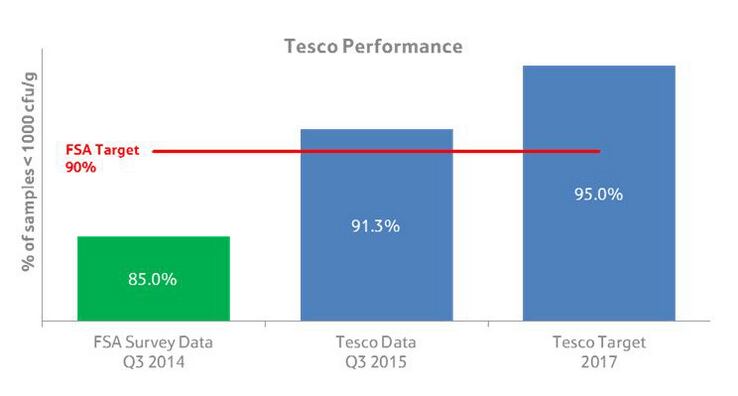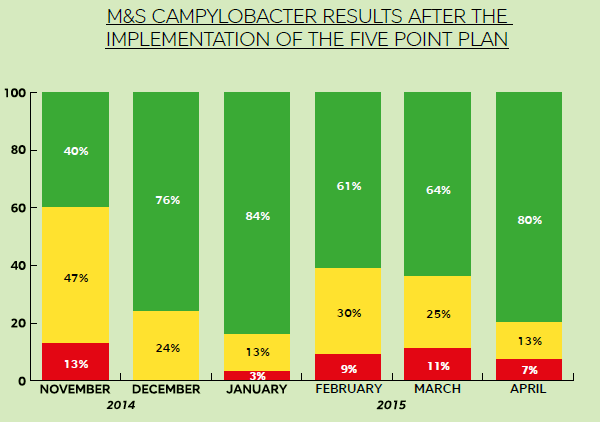It will compare nine of the major retailers, adding Aldi and Lidl to the seven previously listed.
Almost three-quarters of chickens tested positive for Campylobacter, according to results of a year-long study by the FSA published earlier this year.
19% of chickens tested positive within the highest band of contamination –more than 1,000 colony forming units per gram (>1,000 cfu/g).
Tesco and Asda work
Tesco has pledged to meet a target, set by the retailer, of at least 95% of chickens to have minimal levels of the pathogen by 2017. It has introduced leak-proof packaging for all raw poultry to tackle the problem.
The retailer said new data shows chicken which contain Campylobacter at the highest level, has fallen to less than 9% in Q3 this year, compared with 15% recorded by the FSA for the same period in 2014.

Tim Smith, Tesco’s group quality director, said: “It has long been our commitment to reduce levels of Campylobacter in our poultry and we are now seeing real progress at all stages of the supply chain, in tackling the issue through the work we have done with our suppliers.”
Earlier this year, Asda said it was using a steam process, ‘SonoSteam’ proving to reduce Campylobacter by more than 80%. It switched to the process to 30% of its whole birds.
Trials had been on-going at Faccenda Foods since December and it was rolled out full time in June.
Asda is also investing in a No Thin trial with 2 Sisters, which means farmers don’t thin out the flocks of chickens through their natural growing cycle, which is thought can impact Campylobacter levels.
Morrisons and Aldi action
Morrisons said results for the whole of 2015 are below the 7% FSA target.
“This year our results show that on average only 4.8% of chickens tested have the higher levels of contamination compared to the FSA retail target of 7%,” it said.
Morrisons said it is trailing financial incentives for farmers who keep flocks free from Campylobacter.
The retailer said its major chicken supplier has installed a Sonosteam system and in December another main supplier is installing a secondary scalding process. The main supplier has also installed UV equipment to reduce the risk of Campylobacter on the whole bird packaging.
Morrisons said it is working with its suppliers on other processing interventions including, Rapid Surface Chilling.
Aldi said it has invested £2m to tackle the problem and has been monitoring levels in its chickens since 2013.
Supplier, 2Sisters, is using a flock management technique known as “zero-thinning” and feed trials are being done by Banham Poultry.
Lidl, Iceland and Sainsbury’s steps
Lidl said it is has trials looking at the effect of no thinning on Campylobacter, rapid surface chilling and the use of SonoSteam.
It added all flavoured whole birds would change to roast in bag packaging from September this year, reducing the need for consumers to touch raw chicken.
Earlier this year, Sainsbury’s said action was needed within the supply chain to ensure risk is minimised before chicken reaches customers’ homes and customers need to understand what they can do to prevent it.
The retailer said it is investing in advanced entry systems to prevent contamination coming in, ways of heating sheds to keep the litter dry (that stops the bacteria developing) and looking at whether certain food is better at helping the chicken develop healthy bacteria in the gut.
Rapid Surface Chilling, hot washing and chicken packaging were areas it was looking at.
“We also know that Campylobacter gradually declines in number after the chicken has been packed - so we are also researching what is causing this effect with a view to harnessing it for the future,” said Alec Kyriakides, head of food safety at Sainsbury’s.
Iceland said since January it has commissioned an independent laboratory to test more than 200 frozen Iceland products and all have been negative for levels of Campylobacter.
It has required its suppliers to remove the neck skin from whole birds, reduced its number of chilled whole bird suppliers and has introduced leak-proof packaging.
Waitrose, M&S and Co-op plans
Waitrose and fresh chicken supplier Moy Park said earlier this year that the proportion of fresh whole chickens with Campylobacter at the highest level (>1,000 cfu/g) at the end of March fell by two thirds.
The Waitrose/Moy Park Campylobacter action plan includes PCR testing and analysis; biosecurity including double barrier access controls; farmer incentives; flock management systems; washing techniques and factory procedures.
Marks and Spencer’ five point plan includes farmer bonus, zero thinning, blast surface chilling, clear labelling and double bagging.

Before the Five Point Plan was expanded, 11% of M&S chickens had the highest levels of Campylobacter but that had dropped to 7% in April this year, said the retailer.
The Co-op Food said it has signed up to the FSA’s ‘Acting on Campylobacter Together’ (ACT) campaign and are represented on the Board.
It is trailing initiatives from double scalding, blast surface chilling, carcase washing, Campylobacter subject experts at each site and evisceration and hygiene processing interventions.
The retailer has implemented ‘no thinning’ flock management with supplier 2 Sisters from July 2015.
FSA is also hosting a two week visit from the Food and Veterinary Office (FVO) which began on 9 November. The agenda includes legislative and technical discussions and visits to farms, slaughterhouses and laboratories.
“This is welcome particularly in light of the forthcoming negotiations in Brussels which will cover the introduction of a microbiological criterion for Campylobacter at slaughterhouses, the approval of an antimicrobial substance for the decontamination of poultry carcases, and a review of current poultry official controls to better target microbiological hazards such as Campylobacter,” said the agency.
